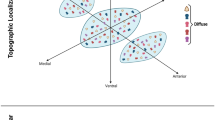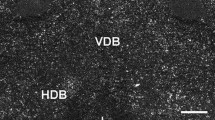Abstract
It is now a recognized principle that various neuropeptides are neuronally co-localized with biogenic amine or aminoacid neurotransmitters. In the rat CNS it has previously been shown that TRH is co-localized with 5-HT (and also with substance P) in cell bodies of the posterior raphe that project to the spinal cord. Although TRH cell bodies are known to be widely distributed throughout the forebrain there is no other known co-localization with 5-HT. In this study we further specify the anatomical relationship of TRH with 5-HT by use of surgical and neurotoxic lesioning with reference to limbic forebrain regions wherein TRH is greatly increased following seizures. In groups of rats, the fimbria-fornix was lesioned alone, or combined with a lesion of the dorsal perforant path or the ventral perforant path. There was a sham lesioned control group. Additional groups were lesioned with 5, 7 dihydroxytryptamine, 100 μg i.v.t., 45 min. after i.p. desipramine, 25 mg/kg. All rats were sacrificed three weeks after lesions. Indoleamines were determined by HPLC in left anterior cortex, left pyriform/olfactory cortex, left dorsal hippocampus and left ventral hippocampus. TRH was determined by specific RIA in the corresponding right brain regions. The modal n was 7 rats. The surgical lesions reduced 5-HT to below the detection limit in dorsal hippocampus in all three groups, and to 31–52% of control in all the ventral hippocampus groups. 5-HIAA was reduced to 19–37% of control in dorsal and to 30–51% of control in ventral hippocampus. TRH was reduced to 44–61% of control in dorsal hippocampus and to 48–53% of control in ventral hippocampus. As was repeatedly observed in our previous reports all TRH levels in ventral hippocampus were higher than in dorsal hippocampus. The 5, 7 dihydroxytryptamine treatment nearly eliminated the indoleamines from all the forebrain regions examined while TRH levels were unchanged. These results can be explained by our previous data showing that immunoreactive TRH is intrinsic and localized to the vicinity of both CA and dentate granule cells of the hippocampus, but about half of hippocampal TRH enters via fibers of the fimbria-fornix. The perforant path appears to contribute no TRH to hippocampus, but, results with the combined lesion groups showed some reduction of 5-HIAA in ventral hippocampus as is expected from the known perforant path contribution of 5-HT. Since the neurotoxic lesion had no effect on TRH, the 5-HT pathway through the fimbria-fornix is probably anatomically separate from a parallel TRH pathway there. This study shows that co-localization of TRH with 5-HT is very unlikely in four specific limbic forebrain regions.
Similar content being viewed by others
References
Chan-Palay, V., Jonsson, G., and Palay, S. L. 1978. Serotonin and substance P coexist in neurons of the rat's central nervous system. Proc. Nat. Acad. Sci. USA 75:1582–1586.
Hokfelt, T., Ljungdahl, A., Steinbusch, H., Verhofstad, A., Nilsson, G., Brodin, E., and Goldstein, M. 1978. Immunohistochemical evidence of substance P-like immunoreactivity in some 5-hydroxytryptamine-containing neurons in the rat central nervous system. Neuroscience 3:517–538.
Johansson, O., Hokfelt, T., Pernow, B., Jeffcoate, S. L., White, N., Steinbusch, H. W. M., Verhofstad, A. A. J., Emson, P. C., and Spindel, E. 1981. Immunohistochemical support for three putative transmitters in one neuron: Coexistence of 5-hydroxytryptamine, substance P- and thyrotropin releasing hormone-like immunoreactivity in medullary neurons projecting to the spinal cord. Neuroscience 6:1857–1881.
Bedard, P., and Pycock, C. J. 1977, ‘Wet-dog’ shake behavior in the rat: a possible quantitative model for central 5-hydroxytryptamine activity. Neuropharmacology 16:663–670.
Sharif, N. A., Burt, D. A., Towle, A. C., Mueller, R. A., and Breese, G. A. 1983. Codepletion of serotonin and TRH induces apparent supersensitivity of spinal TRH receptors. Europ. J. Pharmacol. 95:301–304.
Lechan, R. M., Snapper, S. B., Jacobson, S., and Jackson, I. M. D. 1984. Immunolocalization of the thyrotropin-releasing hormone prohormone in the rat central nervous system. Endocrinology 119:1210–1216.
Carter, D. A., and Lightman, S. L. 1985. Cardio-respiratory actions of substance P, TRH and 5-HT in the nucleus tractus solitarius of rats: evidence for functional interactions of neuropeptides and amine neurotransmitters. Neuropeptides 6:425–436.
Ogawa, N., Kabuto, H., Hirose, Y., Nukina, I., and Mori, A. 1985. Up-regulation of thyrotropin-releasing hormone (TRH) receptors in rat spinal cord after codepletion of serotonin and TRH. Regulatory Peptides 10:85–90.
Helke, C. J., Sayson, S. C., Keeler, J. R., and Charlton, C. G. 1986. Thyrotropin-releasing hormone-immunoreactive neurons project from the ventral medulla to the intermediolateral cell column: partial coexistence with serotonin. Brain Research 381:1–7.
Palkovits, M., Mezey, E., Eskay, R. L., and Brownstein, M. J. 1986. Innervation of the nucleus of the solitary tract and the dorsal vagal nucleus by thyrotropin-releasing hormone-containing raphe neurons. Brain Research 373:246–251.
Towle, A. C., Breese, G. R., Mueller, R. A., Hunt, R., and Lauder, J. M. 1986. Early postnatal administration of 5,7-dihydroxytryptamine: Effects on substance P and thyrotropin-releasing hormone neurons and terminals in rat brain. Brain Research 363:38–46.
Appel, N. M., Wessendorf, M. W., Elde, R. P. 1987. Thyrotropin-releasing hormone in spinal cord: coexistence with serotonin and with substance P in fibers and terminals apposing identified preganglionic sympathetic neurons. Brain Research 415:137–143.
Kitayama, I., Janson, A. M., Fuxe, K., Agnati, L. F., Cintra, A., Ogren, S. O., Harfstrand, A., Eneroth, P., Tsutsumi, T., Jonsson, G., Steinbusch, H. W. M. and Visser, T. J. 1987. Effects of acute and chronic treatment with imipramine on 5-hydroxytryptamine nerve cell groups and on bulbospinal 5-hydroxytryptamine/substance P/thyrotropin releasing hormone immunoreactive neurons in the rat. J. Neural Transmiss. 70:251–285.
Sattin, A., Kubek, M. J., Low, W. C., Staley, C. J., and Simon, J. R. 1988. Dissociation of 5-HT from thyrotropin releasing hormone (TRH) in rat forebrain regions. Society for Neurosci. Abstr. 14:672.
Kubek, M. J., and Sattin, A. 1984. Effect of electroconvulsive shock on the content of thyrotropin-releasing hormone in rat brain. Life Sci. 34:1149–1152.
Kubek, M. J., Meyerhoff, J. L., Hill, T. G., Norton, J. A., and Sattin, A. 1985. Effects of subconvulsive and repeated electroconvulsive shock on thyrotropin-releasing hormone in rat brain. Life Sciences 36:315–320.
Sattin, A., Hill, T. G., Meyerhoff, J. L., Norton, J. A., and Kubek, M. J. 1987. The prolonged increase in thyrotropin-releasing hormone in rat limbic forebrain regions following electroconvulsive shock. Regulatory Peptides 19:13–22.
Kubek, M. J., Low, W. C., Sattin, A., Morzorati, S. L., Meyerhoff, J. L., and Larsen, S. H. 1989. Role of TRH in Seizure Modulation. Ann. N.Y. Acad. Sci. 553:286–303.
Low, W. C., Roepke, J., Farber, S. D., Hill, T. G., Sattin, A., and Kubek, M. J. 1989. Distribution of thyrotropin-releasing hormone (TRH) in the hippocampal formation as determined by radioimmunoassay. Neuroscience Letters 103:314–319.
Low, W. C., Farber, S. D., Hill, T. G., Sattin, A., Zaphiriou, M. R., and Kubek, M. J. 1989. Evidence for extrinsic and intrinsic sources of thyrotropin-releasing hormone (TRH) in the hippocampal formation as determined by radioimmunoassay and immunocytochemistry. Ann. N.Y. Acad. Sci. 553:574–578.
Breese, G. R., Vogel, R. A., and Mueller, R. A. 1978. Biochemical and behavioral alterations in developing rats treated with 5,7-dihydroxytryptamine. J. Pharmacol. Exp. Therap. 205:587–595.
Korpi, E. R. 1984. Serotonin determined in whole blood by liquid chromatography with electrochemical detection. Clinical Chem. 30:487–488.
Kubek, M. J., and Hill, T. G. Pages 261–279.in Hingtgen, J. N., Hellhammer, D. H., and Huppmann, G. (eds.), Advanced methods in Psychobiology, Hogrefe Int'l., Toronto, 1987.
Walaas, I. 1983. The hippocampus. Pages 337–358,in Emson, P. C., (ed.), Chemical Neuroanatomy, Raven Press, N.Y.
Steinbusch, H. W. M. 1981. Distribution of serotonin-immunoreactivity in the central nervous system of the rat—cell bodies and terminals. Neuroscience 4:557–618.
Wallace, J. A., and Lauder, J. M. 1983. Development of the serotonergic system in the rat embryo: an immunocytochemical study. Brain Research Bull. 10:459–479.
Azmitia, E. C., and Segal, M. 1978. An autoradiographic analysis of the differential ascending projections of the dorsal and median raphe nuclei in the rat. J. Compar. Neurol. 179:641–668.
Hokfelt, T., Tsuruo, Y., Ulfhake, B., Cullheim, S., Arvidsson, U., Foster, G. A., Schultzberg, M., Schalling, M., Arborelius, L., Freedman, J., Post, C., and Visser, T. 1989. Distribution of TRH-like immunoreactivity with special reference to coexistence with other neuroactive compounds. Ann. N. Y. Acad. Sci. 553:76–105.
Aprison, M. H., Takahashi, R., and Tachiki, K. 1978. Hypersensitive serotonergic receptors involved in clinical depression—a theory. Pages 23–53,in Haber, B., and Aprison, M. H., (eds.), Neuropharmacology and Behavior, Plenum Press, N.Y.
Hingtgen, J. N., Hendrie, H. C., and Aprison, M. H. 1984. Postsynaptic serotonergic blockade following chronic antidepressive treatment with trazodone in an animal model of depression. Pharmacol. Biochem. and Behavior 20:425–428.
Hingtgen, J. N., Shekhar, A., DiMicco, J. A., and Aprison, M. H. 1988. Response suppression in rats after bilateral microinjection of 5-hydroxytryptophan in lateral hypothalamus. Biol. Psychiat. 23:711–718.
Asberg, M., Thoren, P., Traskman, L., Bertilsson, L., and Ringberger, V. 1976. Serotonin depression: a biochemical subgroup within the affective disorders? Science 191:478–480.
Van Praag, H. M. 1977. New evidence of serotonin-deficient depressions. Neuropyschobiology 3:56–63.
Fuller, R. W. 1980. Pharmacology of central serotonin neurons. Ann. Rev. Pharmacol. Toxicol. 20:111–127.
Sattin, A. 1987. A possible role for thyrotropin releasing hormone (TRH) in antidepressant treatment. Pages 549–555,in Ehrlich, Y. H., Lenox, R. H., and Kornecki, E. (eds.), Molecular Mechanisms of Neuronal Responsiveness, Plenum Press, N.Y.
Author information
Authors and Affiliations
Additional information
Special issue dedicated to Dr. Morris H. Aprison.
Rights and permissions
About this article
Cite this article
Sattin, A., Kubek, M.J., Low, W.C. et al. Some regional anatomical relationships of TRH to 5-HT in rat limbic forebrain. Neurochem Res 17, 469–473 (1992). https://doi.org/10.1007/BF00969894
Accepted:
Issue Date:
DOI: https://doi.org/10.1007/BF00969894




